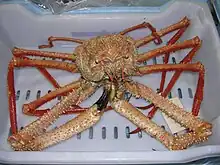
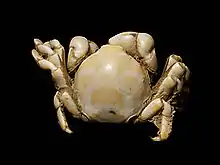
Around 65 species of crab occur in the waters of the British Isles.[1][Note 1] All are marine, with the exception of the introduced Chinese mitten crab, Eriocheir sinensis, which occurs in fresh and brackish water. They range in size from the deep-water species Paromola cuvieri,[3] which can reach a claw span of 1.2 metres (3 ft 11 in),[4] to the pea crab, which is only 4 mm (0.16 in) wide and lives inside mussel shells.
Fisheries
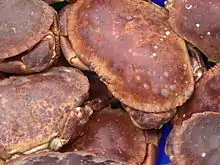
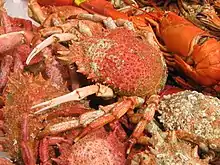
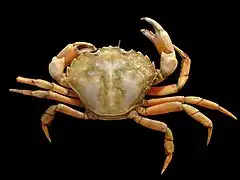
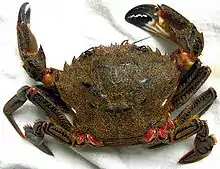
Several species of wild crab are the subject of crab fisheries around the coasts of the British Isles. The most important are the brown crab or edible crab, Cancer pagurus (29,193 t), various swimming crabs (3,180 t), the spider crab Maja brachydactyla (1,565 t), the shore crab or green crab Carcinus maenas (553 t) and the velvet crab Necora puber (193 t). Around 77% of the catch is landed in the United Kingdom, 19% in Ireland, 4% in the Channel Islands, and 1% in the Isle of Man.[Note 2]
Species
62 species have been directly observed in the waters of the British Isles:[1][Note 3]
- Dromia personata (Linnaeus, 1758)
- Paromola cuvieri (Risso, 1816)
- Ebalia cranchii Leach, 1817
- Ebalia granulosa H. Milne-Edwards, 1837
- Ebalia nux A. Milne-Edwards, 1883
- Ebalia tuberosa (Pennant, 1777)
- Ebalia tumefacta (Montagu, 1808)
- Maja brachydactyla Balss, 1922
- Eurynome aspera (Pennant, 1777)
- Eurynome spinosa Hailstone, 1835
- Hyas araneus (Linnaeus, 1758)
- Hyas coarctatus Leach, 1815
- Achaeus cranchii Leach, 1817
- Inachus dorsettensis (Pennant, 1777)
- Inachus leptochirus Leach, 1817
- Inachus phalangium (Fabricius, 1775)
- Macropodia deflexa Forest, 1978
- Macropodia linaresi Forest & Zariquiey Alvarez, 1964
- Macropodia rostrata (Linnaeus, 1761)
- Macropoda tenuirostris (Leach, 1814)
- Pisa armata (Latreille, 1803)
- Pisa tetraodon (Pennant, 1777)
- Parthenopides massena (Roux, 1830)
- Corystes cassivelaunus (Pennant, 1777)
- Atelecyclus rotundatus (Olivi, 1792)
- Atelecyclus undecimdentatus (Herbst, 1783)
- Thia scutellata (Fabricius, 1793)
- Pirimela denticulata (Montagu, 1808)
- Cancer bellianus Johnson, 1861
- Cancer pagurus Linnaeus, 1758
- Callinectes sapidus Rathbun, 1896
- Carcinus maenas (Linnaeus, 1758)
- Bathynectes longipes (Risso, 1816)
- Bathynectes maravigna (Prestandrea, 1839)
- Liocarcinus corrugatus (Pennant, 1777)
- Liocarcinus depurator (Linnaeus, 1758)
- Liocarcinus holsatus (Fabricius, 1798)
- Liocarcinus marmoreus (Leach, 1814)
- Liocarcinus navigator (Herbst, 1794)
- Liocarcinus pusillus (Leach, 1815)
- Liocarcinus zariquieyi Gordon, 1968
- Macropipus tuberculatus (Roux, 1830)
- Necora puber (Linnaeus, 1767)
- Polybius henslowii Leach, 1820
- Portumnus latipes (Pennant, 1777)
- Xaiva biguttata (Risso, 1816)
- Geryon trispinosus (Herbst, 1803)
- Goneplax rhomboides (Linnaeus, 1758)
- Monodaeus couchi (Couch, 1851)
- Xantho hydrophilus (Herbst, 1790)
- Xantho pilipes A. Milne-Edwards, 1867
- Dyspanopeus sayi (S. I. Smith, 1869)
- Rhithropanopeus harrisii (Gould, 1841)
- Pilumnoides inglei Guinot & Macpherson, 1987
- Pilumnus hirtellus (Linnaeus, 1761)
- Pachygrapsus marmoratus (Fabricius, 1787)
- Planes minutus (Linnaeus, 1758)
- Brachynotus sexdentatus (Risso, 1827)
- Eriocheir sinensis H. Milne-Edwards, 1853
- Asthenognathus atlanticus Monod, 1933
- Nepinnotheres pinnotheres (Linnaeus, 1758)
- Pinnotheres pisum (Linnaeus, 1767)
Three deep-water species have also been recorded near the British Isles, and are likely to occur in the area. These are:[1]
- Cymonomus granulatus (Norman in Wyville Thomson, 1873) (Cymonomidae)
- Dorhynchus thomsoni Wyville Thomson, 1873 (Inachidae)
- Rochinia carpenteri (Wyville Thomson, 1873) (Epialtidae)
Notes
- ↑ Howson & Picton define the waters of the British Isles to be the area within the 200 metres (660 ft) isobath surrounding the British Isles, between 48 °N and 62.5 °N, and between 13 °W and 6 °E; this includes the English Channel and parts of the North Sea coasts of Belgium and the Netherlands, but excludes the Faroe Islands.[2]
- ↑ Fishery data is for the year 2009, and is taken from the FAO's online database, summing the captures for the Channel Islands, Isle of Man, Ireland and the United Kingdom.[5]
- ↑ Nomenclature follows Ng et al. (2009).[6]
References
- 1 2 3 J. M. C. Holmes; M. J. Costello & D. W. Connor (1997). "Crustacea". In Christine M. Howson & Bernard E. Picton (eds.). The Species Directory of the Marine Fauna and Flora of the British Isles and Surrounding Seas (PDF). Ulster Museum and the Marine Conservation Society. pp. 142–209. ISBN 978-0-948150-06-7.
- ↑ Christine M. Howson & Bernard E. Picton, eds. (1997). "Introduction". The Species Directory of the Marine Fauna and Flora of the British Isles and Surrounding Seas (PDF). Ulster Museum and the Marine Conservation Society. pp. 5–8. ISBN 978-0-948150-06-7.
- ↑ Michael McCarthy (April 22, 2010). "Britain's biggest crab emerges from the deep". The Independent. Retrieved February 12, 2012.
- ↑ Mike Thurston (1987). "Record breaking crab is not such a strange catch". New Scientist. 114 (1554): 24.
- ↑ "Global Capture Production 1950–2009". Food and Agriculture Organization. Retrieved February 12, 2012.
- ↑ Peter K. L. Ng; Danièle Guinot & Peter J. F. Davie (2008). "Systema Brachyurorum: Part I. An annotated checklist of extant Brachyuran crabs of the world" (PDF). Raffles Bulletin of Zoology. 17: 1–286. Archived from the original (PDF) on 2011-06-06.